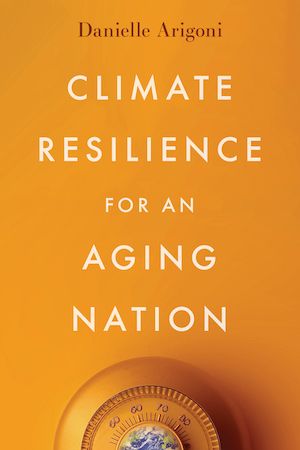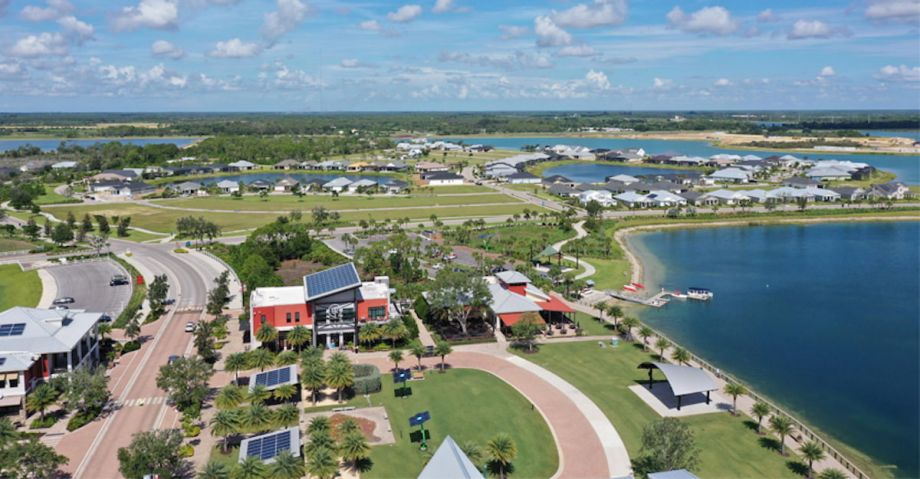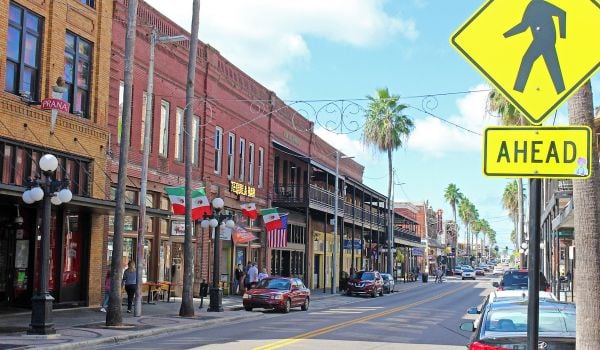This is an adapted excerpt from “Climate Resilience for an Aging Nation” by Danielle Arigoni. It is printed here with permission from Island Press.
The health and safety we enjoy as individuals and the opportunities for employment, education, and recreation available to us are shaped to a large degree by the built environment in which we live. For the past 70 years, the vast majority of new housing development has followed the example of Levittown, New York.
The city now serves as the poster child for a seemingly endless wave of car-dependent greenfield suburban sprawl developments that not only helped to generate the carbon emissions that contribute to the climate crisis we now face but also modeled a form of growth that provided opportunity for wealth creation for some households and not others. Cookie-cutter single-family detached homes were constructed that put the American ideal of homeownership within reach — if you were of the right race, gender, marital status, profession, and household size.

Babcock Ranch may serve as that new type of model community. Built on principles of climate resilience, sustainability, and choice, this 18,000–acre master-planned community of 2,000 homes near Fort Myers, Florida, was designed to withstand the area’s hurricanes — and succeeded, given the negligible impact to its 5,000 residents during Hurricane Ian in late 2022.
Babcock Ranch homes were constructed according to FORTIFIED building standards, and thus were able to withstand the category 4 storm and use energy from on-site 150-plus megawatt solar arrays (plus battery storage) sufficient to power up to 30,000 homes — all of which are connected by buried power lines to ensure reliability during extreme weather events. The site uses stormwater management best practices and filter marshes to reduce flooding, protect watersheds, and reduce on-site water demand. It incorporates a range of housing options — from condos in multifamily apartment buildings to single-family attached villas to single-family detached homes — all built to be energy efficient and meet Florida’s Green Building standards.
Technology is used to connect people to one another and to resources through high-speed fiber-optic internet service in all homes and free WiFi in common areas. Public amenities include parks and trails throughout the surrounding 50,000 acres of preserved land, an on-site health center, a neighborhood school, and a community center that doubles as a reinforced storm shelter capable of serving area residents beyond Babcock Ranch. Transportation options within the development include 50 miles of an active trail system to encourage walking and biking and pilot use of autonomous vehicle shuttles for residents and prospective home buyers.
Babcock Ranch is surely not perfect, nor is it wholly replicable, given that it is a greenfield development of all-new construction. Planned developments such as Babcock Ranch tend to be home to a wealthier, more educated, and whiter population. But it nevertheless serves as a powerful illustration of the value of an intentional, cross-sectoral, community-wide approach to resilience — one that needs to be applied to all places, particularly places where older adults already live and most urgently in areas that already face acute climate risks. Doing so requires action by the private sector, all levels of government, quasi-governmental public utility commissions and multi-jurisdictional planning and transportation authorities; and community-based organizations. It will take all of these entities and more to commit to a shared vision of community resilience if we are to achieve it.
Committing to Community-Scale Resilience
Systemic change is needed because the ability to prepare to survive or even thrive in the face of climate-related disasters goes well beyond the capacity of any person or entity. The long list of disasters in which older adults constitute the majority of deaths shows us that the failures to reduce risk for older adults are systemic. Older adults need reliable and affordable energy, safe and secure housing, responsive and redundant transportation, stronger social infrastructure, better emergency response support, and more adaptive approaches to healthcare but communities in their current form often fall short.
Of course, there is a role for individual preparation. But addressing these failures in the broader system by committing to community-scale resilience is essential to reduce deaths during disasters, as well as to help older adults thrive every day in the face of an ever-changing climate.
Building community resilience requires committing to community-scale actions that reduce risk. Investments in hard infrastructure that seek to enhance the safety and stability of entire districts — such as the levee system in New Orleans to manage flooding, the seawall being constructed around Lower Manhattan to protect the region from future storm surges like the one it experienced during Hurricane Sandy, and other such large-scale projects — are of course critical to increasing resilience and will always remain so. So too are policy solutions like the adoption of stricter building requirements that reduce energy use and ensure new construction can better withstand hurricanes, tornadoes, or wildfires. Equally important are efforts to map and better assess risk using available tools — particularly when coupled with a robust public engagement process — to help states and localities effectively deploy scarce resources. Any and all of these can add to the incremental resilience of a community and its residents, regardless of age.
A commitment to achieve true resilience for all ages requires still more focused effort in which communities center their planning in an understanding of how aging individuals experience risk. Doing so can and must be integrated into planning for disasters, as well as in the making of everyday investments in public infrastructure. States and communities can take meaningful steps to advance resilience in their traditional budgeting processes, in planning for transportation and housing, and in prioritizing investments for needed infrastructure. Entities that are members of the AARP Network of Age-Friendly States and Communities may have an advantage in that they have an established process for developing and implementing an action plan centered on older adults’ needs that could be deployed to target a goal of reducing climate-related risk for all ages.
But there truly is a role for every sector and every community to advance resilience for older adults. Any and all levels of government would be well served to strengthen their focus on older adults by committing to interventions. But the responsibility does not lie only with the public sector. Private and nonprofit entities — ranging from healthcare providers to utilities to housing developers to aging advocates and beyond — must do their part by first acknowledging the impact climate change has on the people they serve and then committing to deliver more sustainable and resilient outcomes. Only by embracing greater collaboration with diverse partners can we create a better future for us all.

Danielle Arigoni is the Managing Director for Policy and Solutions at National Housing Trust. She previously served as the Director of Livable Communities at AARP where she led efforts to help communities implement safe, walkable streets; age-friendly housing and transportation options; and greater opportunities for residents of all ages to participate in community life. She is also the former director of the Office of Economic Resilience at the US Department of Housing and Urban Development (HUD).
















